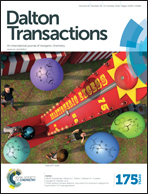Boron complexes of aromatic ring fused iminopyrrolyl ligands: synthesis, structure, and luminescence properties†
Abstract
The condensation reactions of 2-formylindole (1) or 2-formylphenanthro[9,10-c]pyrrole (2) with various aromatic amines afforded the corresponding phenyl or phenanthrene ring fused mono-/bis-iminopyrrole ligand precursors 3–8, which, upon reaction with BPh3 in an appropriate molar ratio, led to the new mono- and diboron chelate compounds Ph2B[NC8H5C(H)![[double bond, length as m-dash]](https://www.rsc.org/images/entities/char_e001.gif) N-2,6-Ar] (Ar = 2,6-iPr2C6H39; C6H510), Ph2B[(NC8H5C(H)
N-2,6-Ar] (Ar = 2,6-iPr2C6H39; C6H510), Ph2B[(NC8H5C(H)![[double bond, length as m-dash]](https://www.rsc.org/images/entities/char_e001.gif) N)2-1,4-C6H4]BPh211, Ph2B(NC16H9C(H)
N)2-1,4-C6H4]BPh211, Ph2B(NC16H9C(H)![[double bond, length as m-dash]](https://www.rsc.org/images/entities/char_e001.gif) N-Ar) (Ar = 2,6-iPr2C6H312; C6H513), and Ph2B[(NC16H9C(H)
N-Ar) (Ar = 2,6-iPr2C6H312; C6H513), and Ph2B[(NC16H9C(H)![[double bond, length as m-dash]](https://www.rsc.org/images/entities/char_e001.gif) N)2-1,4-C6H4]BPh214, respectively. Boron complexes 12–14, containing a phenanthrene fragment fused to the pyrrolyl C3–C4 bond, are highly fluorescent in solution, with quantum efficiencies of 37%, 61% and 58% (in THF), respectively, their emission colours ranging from blue to orange depending on the extension of π-conjugation. Complexes 9–11, containing a benzene fragment fused to the pyrrolyl C4–C5 bond, are much weaker emitters, exhibiting quantum efficiencies of 10%, 7% and 6%, respectively. DFT and TDDFT calculations showed that 2,6-iPr2C6H3N-substituents or, to a smaller extent, the indolyl group prevent a planar geometry of the ligand in the excited state and reveal the existence of a low energy weak band in all the indolyl complexes, which is responsible for the different optical properties. Non-doped single-layer light-emitting diodes (OLEDs) were fabricated with complexes 9–14, deposited by spin coating, that of complex 13 revealing a maximum luminance of 198 cd m−2.
N)2-1,4-C6H4]BPh214, respectively. Boron complexes 12–14, containing a phenanthrene fragment fused to the pyrrolyl C3–C4 bond, are highly fluorescent in solution, with quantum efficiencies of 37%, 61% and 58% (in THF), respectively, their emission colours ranging from blue to orange depending on the extension of π-conjugation. Complexes 9–11, containing a benzene fragment fused to the pyrrolyl C4–C5 bond, are much weaker emitters, exhibiting quantum efficiencies of 10%, 7% and 6%, respectively. DFT and TDDFT calculations showed that 2,6-iPr2C6H3N-substituents or, to a smaller extent, the indolyl group prevent a planar geometry of the ligand in the excited state and reveal the existence of a low energy weak band in all the indolyl complexes, which is responsible for the different optical properties. Non-doped single-layer light-emitting diodes (OLEDs) were fabricated with complexes 9–14, deposited by spin coating, that of complex 13 revealing a maximum luminance of 198 cd m−2.


 Please wait while we load your content...
Please wait while we load your content...